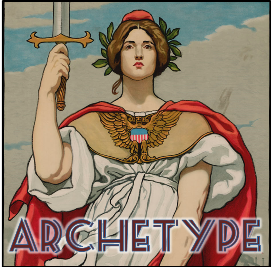 We’re two roles deep in the Writing Archetypes series (Hero and Rough), and it might be a good time to make an important point about what archetypes are.
We’re two roles deep in the Writing Archetypes series (Hero and Rough), and it might be a good time to make an important point about what archetypes are.
When encountering reversals, doubles, and conflations of archetypes, we can start to feel lost trying to identify who’s who. It’s important to remember that when talking archetypes, we’re really talking about semantic fields rather than characters.
It helps to think of an archetype as a matching three-piece suit. Sure, the pieces naturally make a set, but mixing and matching can also turn up some interesting fashion statements. As can leaving a piece out.
This is how a reversal can ironically invoke the archetype it reverses. For example, in the Clint Eastwood masterpiece Unforgiven (which I’ll examine in more depth later), the Schofield Kid plays the Rough role but, as we discover, his dishonest boasting contrasts sharply with William Munny’s truly rough past. His relative youth also flips the Hero-Rough dynamic on its head, since the Rough is typically older than the Hero.
By being so outrageously fake, the false Rough still brings the energy of the Rough into the viewer’s consciousness by its glaring absence, or by displacing it noticeably onto another character. It’s like a naked man walking into a five-star restaurant: his nudity immediately raises questions about the suit he should be wearing.
Doubling, on the other hand, helps pick apart the different parts of an archetypal bundle. We saw this in the last installment when examining Aragorn and Boromir of The Fellowship of the Ring. Aragorn is too much of a good guy to express the more villainous or cynical aspects of the Rough: his cynicism is primarily aimed at his own heritage. Aragorn also gets along too well with Gandalf to pull off the required Guru-Rough rivalry.
Enter Boromir, whose worldly and cynical strategizing comes into direct conflict with Gandalf’s otherworldly strategizing. Boromir also turns on the Hero (something Aragorn could never do) in order to fulfill another role of the Rough.
Doubling helps us see that archetypes are really semantic bundles rather than discrete roles. With a large cast, any of the recognizable archetypes can have its pieces distributed over several characters.
On the other hand, in a small cast, there are often not enough characters to go around. This can lead to two archetypes being conflated in one character.
For example, the role John the Baptist plays in the story of Jesus can be seen as a conflation of the Rough and the Guru. John is a bit older, lives away from civilized society, and wears a camel-hair shirt, all ticking off items on the Rough checklist. However, John baptizes Jesus, recognizes his destiny, and is killed by the Villains halfway through the story, all ticking off items on the Guru checklist.
It might seem that the story of a man with twelve disciples would have characters to spare for all of the archetypes, but the disciples are all below the Hero in the narrative hierarchy and the narrative space above a character like Jesus is necessarily cramped. He is the Son of God, after all. Having two characters of greater experience simply won’t do, so John lightly touches both the Rough and Guru energies without upstaging the Hero.*
By keeping in mind that archetypes do not necessarily equate to characters can both help us understand how they function, and make us better readers, viewers, and writers. As atoms are combined in chemistry and broken in nuclear physics, the power in a story is often unleashed by splitting up or combining the archetypal bundles.
Next week: the Guru!
_
* If you’re a devout Christian, you might take exception with me analyzing a real-life story as if it were fiction. But, as we’ll see in a later installment, the reason archetypes work is that they derive from real-life interpersonal dynamics, particularly between generations.
